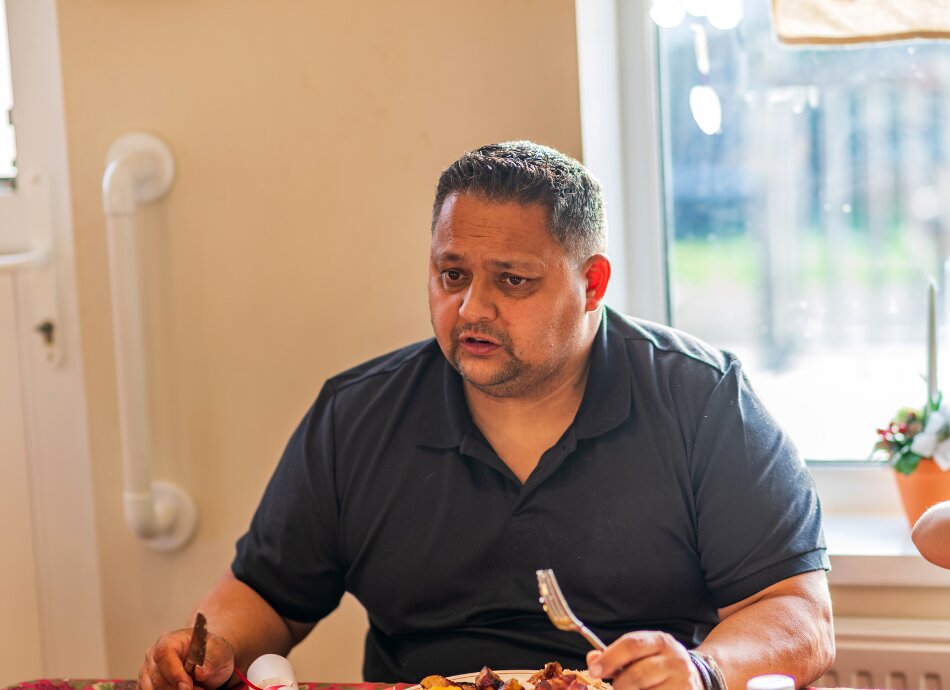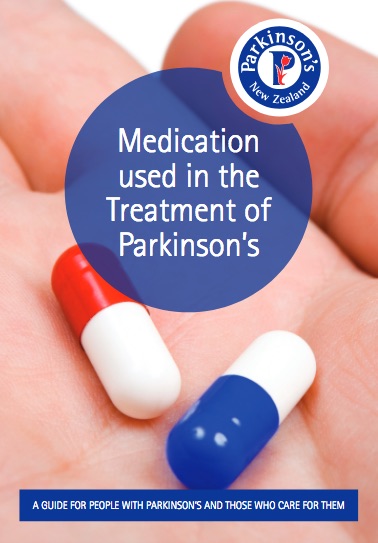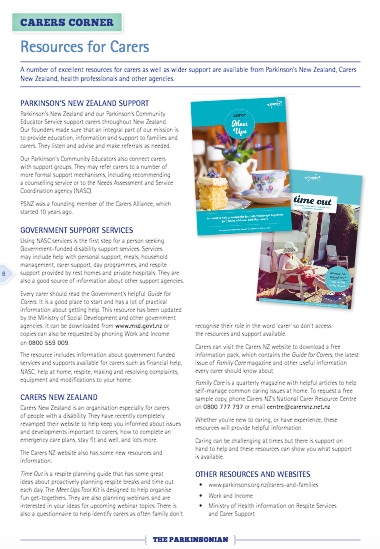Parkinson's overview | Mate pākenetana
Also known as Parkinson's disease
Key points about Parkinson's disease
- Parkinson’s is one of the most common neurological (brain and nervous system) conditions. It affects movement and coordination.
- Most people develop it between the ages of 55 to 65 years. Symptoms get worse slowly over about 15 years.
- The first sign of Parkinson’s is often a tremor or slowness of movement.
- There is currently no cure for Parkinson’s, but symptoms can be treated with medication, surgery and lifestyle changes.
- It’s important that anyone with Parkinson’s and their family/whānau get information about the condition and support to manage it.

Parkinson’s is a neurological condition, which means it affects your brain and nervous system. It is progressive, which means it gradually gets worse. You do not suddenly develop Parkinson’s. The condition develops slowly as nerves in a part of your brain called the substantia nigra degenerate or die slowly.
Parkinson’s has both motor and non-motor symptoms:
- motor symptoms include control of coordination, movement and mobility
- non-motor symptoms include things such as changes to your senses, energy levels, mood and cognitive abilities (perception, memory, judgement, reasoning, etc).
Parkinson’s is often called Parkinson’s disease. However, it is not contagious and can't be spread from one person to another. With good medical treatment, Parkinson's generally has only a minor effect on life expectancy.
Video: What is Parkinson's?
This video may take a few moments to load.
(Parkinson's UK, 2017)
About 1 in 500 people have Parkinson’s. Most people develop it between 55 to 65 years of age.
- Parkinson’s is most common in older people. About 1 in 100 people over the age of 60 are diagnosed with Parkinson’s.
- Parkinson’s in people younger than 60 years of age is known as early-onset Parkinson’s. Of people diagnosed with Parkinson’s, about 1 in 20 are younger than 40 years.
- In rare cases, Parkinson’s-like symptoms can occur in children and teenagers. This is known as juvenile parkinsonism and is considered to be a separate condition to Parkinson’s.
There is a very small increase in Parkinson’s risk in people with family/whānau who have Parkinson’s.
Parkinson’s is caused by a loss of nerve cells in the part of the brain called the substantia nigra. These nerve cells are responsible for producing a chemical called dopamine. Dopamine acts as a messenger between the parts of the brain and nervous system that help control and co-ordinate body movements.
With dopamine, you can have quick, well-coordinated movement. When dopamine levels fall, movements become slow and awkward.
It is not known why this develops in some people. Researchers are looking into possible causes, including genetic changes and environmental factors, such as toxic chemicals.
Parkinson’s is broken into early and late stages.
- Early-stage – mild symptoms or disability.
- Late-stage – motor symptoms have further developed and there is more limitation in day-to-day life.
The three main symptoms of Parkinson's disease affect your physical movement (motor symptoms):
- Tremor
- About 70% of people with Parkinson’s have a tremor.
- The tremor involves shaking, particularly when resting. It often occurs in one hand or arm rather than both (at least to start with).
- Stiffness
- Rigid muscles can make it harder to turn over in bed, get out of a chair, do up buttons, etc.
- Stiffness can also affect your posture and facial expressions and lead to aches in your muscles.
- Slowness of movement (also known as bradykinesia)
- It can be hard to start a movement, or it might take you longer to do a task.
- This can also affect repetitive movements, like handwriting and getting dressed.
You may also experience a range of other physical and mental symptoms (non-motor symptoms), such as:
- depression, anxiety or loss of interest in life
- disturbance of normal sleep
- extreme tiredness
- lack of sense of smell
- constipation
- trouble swallowing or speaking
- skin sensations and pain.
The main symptoms of Parkinson's are also the main symptoms of a number of conditions that are grouped together under the term parkinsonism.
What is parkinsonism?
Parkinsonism is an umbrella term for neurological disorders that cause Parkinson’s-like movement problems, such as tremors, slow movement and stiffness. Parkinson’s is the most common condition in this area, but there are other conditions that can cause these symptoms.
These conditions tend to progress faster than Parkinson’s, and people with them experience extra symptoms, such as falling over in the early stages of the condition, dementia or hallucinations. They also don’t respond as well to the usual Parkinson’s treatment.
If specialists see unusual symptoms and a poor response they may start to question whether the person has Parkinson's or another parkinsonism condition.
There are no tests that show that you have Parkinson's. Your doctor will base a diagnosis on your symptoms, medical history and a detailed physical examination.
They will ask about your symptoms. They may also ask you to do some simple mental or physical tasks, such as moving or walking around.
It can be hard to diagnose Parkinson’s in the early stages because symptoms are usually mild at first. If your doctor thinks you might have Parkinson's, they will refer you to a specialist. This will usually be a neurologist (a specialist in conditions affecting the brain and nervous system) or a geriatrician (a specialist in conditions affecting older adults).
Although there's currently no cure for Parkinson's, treatments are available to help reduce symptoms and maintain quality of life for as long as possible. These include:
- supportive therapies, such as physiotherapy and occupational therapy
- medication
- deep brain stimulation (DBS).
If you have mild symptoms of Parkinson’s, your doctor might not recommend medication and instead focus on supportive therapy and lifestyle improvements such as exercise and relaxation. As your symptoms progress, you will be prescribed medication.
Supportive therapies
There are several therapies that can make living with Parkinson's easier and help you deal with your symptoms on a day-to-day basis. These include the following:
- Physiotherapy to relieve muscle stiffness and joint pain through movement (manipulation) and exercise.
- Occupational therapy to work out practical solutions to difficulties in your everyday life, such as dressing yourself or getting to the local shops.
- Speech and language therapy to help with swallowing difficulties and problems with speech.
- Diet advice, as making dietary changes can help improve some symptoms. These changes can include:
- increasing the amount of fibre in your diet and making sure you're drinking enough fluid to reduce constipation
- increasing the amount of salt in your diet and eating small, frequent meals to avoid problems with low blood pressure, such as dizziness when you stand up quickly
- making changes to your diet to avoid unintentional weight loss.
Medication
Medicines do not prevent Parkinson's but they aim to improve your daily functioning. Medicines are usually started when symptoms disrupt your daily life. Everybody's experience of Parkinson's is different and your healthcare team will work with you to find the best treatments for your particular symptoms. Depending on your symptoms and responses to medicines, you may need to try a combination of medicines, and your medicines may change over time as your symptoms change. Examples of medicines for Parkinson’s include levodopa + benserazide, levodopa + carbidopa, ropinirole, pramipexole, entacapone, tolcapone, selegiline and amantadine.
Read about medicines for Parkinson's, including tips for when taking them and medicines to avoid.
Your doctor will also prescribe medication and other treatments as necessary to help you manage other symptoms, such as depression, pain, gastrointestinal problems, etc.
Deep brain stimulation (DBS)
DBS is a therapy aimed at treating multiple symptoms in some people with late-stage Parkinson’s.
- DBS stimulates a specific part of your brain with mild electrical pulses.
- The DBS treatment leads to better symptom management. It can mean a 30% to 40% reduction in the amount of medication you need.
- In New Zealand, fewer than 20 people receive DBS treatment annually (because it is only effective in some people).
Read more about deep brain stimulation(external link).
Apps reviewed by Healthify
You may find it useful to look at some Parkinson's apps, Physiotherapy and exercise apps, Swallowing difficulty apps, Self-management and healthy living apps and Healthy ageing and wellness apps.
Video: Parkinson's service dogs
This video may take a few moments to load.
(Parkinson's NZ, 2013)
Video: Can't make it stop - Karen's Parkinson's story
This video may take a few moments to load.
(Parkinson's UK, 2021)
Video: I made a film about my Parkinson's diagnosis
This video may take a few moments to load.
(Parkinson's UK, 2021)
Video: Dad Living With Parkinson's
This video may take a few moments to load.
(Attitude NZ, 2016)
Videos – parents with Parkinson's talk about raising children, also get advice from a social worker & a psychiatrist.
In these videos:
- A social worker and psychiatrist provide tips for raising teenagers if you have Parkinson's.
- A round table discussion from parents with Parkinson's who are raising teenage or adolescent children.
- A mother talks about raising children when you have been diagnosed with Parkinson's.
Video: Advice for people with Parkinson's who have teenage children
Elaine Book, social worker from the Pacific Parkinson's Research Centre in Vancouver Canada and David Morley, psychiatrist, from the University of Oxford UK, give their advice on parenting teenagers if you have Parkinson's. This video may take a few moments to load.
(Parkinson's NZ, 2013)
Video: Round table discussion – teenagers and adolescents
Sharon Daborn talks about the results of a round table discussion on people with Parkinson's who have teenage or adolescent children. This video may take a few moments to load.
(Parkinson's NZ, 2013)
Video: Raising kids after a Parkinson's diagnosis
Soania Mathur (Canada) talks about raising kids when you have been diagnosed with Parkinson's. This video may take a few moments to load.
(Parkinson's NZ, 2013)
If you have been diagnosed with Parkinson's, it's important that you get support for yourself. You may also be entitled to financial support. Find out more about support for living with Parkinson's.
Resources(external link) Parkinson’s NZ
Getting the most out of your Parkinson's medicines University of Auckland, People With Parkinson's Inc. & Waitemata DHB
Parkinson's disease(external link) Better Health Australia, 2017
Parkinson's disease(external link) Patient Info, UK, 2019
Parkinson's - a guide for the newly diagnosed(external link) Parkinson's NZ, 2019
Medication used in the treatment of Parkinson's(external link) Parkinsons NZ, 2015
Resources for carers(external link) Parkinsons NZ
Apps
Parkinson's apps
Physiotherapy and exercise apps
Swallowing difficulty apps
Self-management and healthy living apps
Healthy ageing and wellness apps
References
- What is Parkinson’s?(external link) Parkinson’s NZ
- Auckland Regional Health Pathways, NZ, 2019
- Parkinson's disease vs parkinsonisms(external link) Parkinson’s Foundation, US, 2018
- Parkinson's disease(external link) NHS, UK, 2016
- The management of Parkinson’s disease – which treatments to start and when?(external link) BPAC, NZ, 2014
Brochures

Parkinsons NZ, 2015

Parkinsons NZ
Credits: Healthify editorial team. Healthify is brought to you by Health Navigator Charitable Trust.
Reviewed by: Dr Helen Kenealy, geriatrician and general physician, Counties Manukau DHB
Last reviewed:
Page last updated:





